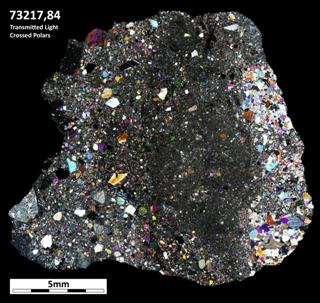Feb 13 2015
It's been more than 40 years since astronauts returned the last Apollo samples from the moon, and since then those samples have undergone some of the most extensive and comprehensive analysis of any geological collection. A team led by ASU researchers has now refined the timeline of meteorite impacts on the moon through a pioneering application of laser microprobe technology to Apollo 17 samples.
 This is a photomicrograph of a petrographic thin section of a piece of a coherent, crystalline impact melt breccia collected from landslide material at the base of the South Massif, Apollo 17 (sample 73217, 84). Different mineral and lithic clasts, as well as impact melt phases are evident. Credit: Brad Jolliff, Washington University in St. Louis.
This is a photomicrograph of a petrographic thin section of a piece of a coherent, crystalline impact melt breccia collected from landslide material at the base of the South Massif, Apollo 17 (sample 73217, 84). Different mineral and lithic clasts, as well as impact melt phases are evident. Credit: Brad Jolliff, Washington University in St. Louis.
Impact cratering is the most ubiquitous geologic process affecting the solid surfaces of planetary bodies in the solar system. The moon's scarred surface serves as a record of meteorite bombardment that spans much of solar system history. Developing an absolute chronology of lunar impact events is of particular interest because the moon is an important proxy for understanding the early bombardment history of Earth, which has been largely erased by plate tectonics and erosion, and because we can use the lunar impact record to infer the ages of other cratered surfaces in the inner solar system.
Researchers in ASU's Group 18 Laboratories, headed by Professor Kip Hodges, used an ultraviolet laser microprobe attached to a high-sensitivity mass spectrometer to analyze argon isotopes in samples returned by Apollo 17. While the laser microprobe 40Ar/39Ar technique has been applied to a large number of problems in terrestrial geochronology, including studies of texturally complex samples, this is its first time it has been applied to samples from the Apollo archive.
The samples analyzed by the ASU team are known as lunar impact melt breccias -- mash-ups of glass, rock and crystal fragments that were created by impact events on the moon's surface.
When a meteor strikes another planetary body, the impact produces very large amounts of energy, some of which goes into shock heating and melting the target rocks. These extreme conditions can 'restart the clock' for some mineral-isotopic chronometers, particularly for material melted during impact. As a result, the absolute ages of lunar craters are primarily determined through isotope geochronology of components of the target rocks that were shocked and heated to the point of melting, and which have since solidified.
However, lunar rocks may have experienced multiple impact events over the course of billions of years of bombardment, potentially complicating attempts to date samples and relate the results to the ages of particular impact structures.
Conventional wisdom holds that the largest impact basins on the moon were responsible for generating the vast majority of impact melts, and therefore that nearly all of the samples dated must be related to the formation of those basins.
While it is true that enormous quantities of impact melt are generated by basin-scale impact events, recent images taken by the Lunar Reconnaissance Orbiter Camera confirm that even small craters with diameters on the order of 100 meters can generate impact melts. The team's findings have important implications for this particular observation. The results are published in the inaugural issue of the American Association for the Advancement of Science's newest journal, Science Advances, on Feb. 12.
"One of the samples we analyzed, 77115, records evidence for only one impact event, which may or may not be related to a basin-forming impact event. In contrast, we found that the other sample, 73217, preserves evidence for at least three impact events occurring over several hundred million years, not all of which can be related to basin-scale impacts," says Cameron Mercer, lead author of the paper and a graduate student in ASU's School of Earth and Space Exploration.
Sample 77115, collected by astronauts Gene Cernan and Harrison Schmitt at Station 7 during their third and final moonwalk, records a single melt-forming event about 3.83 billion years ago. Sample 73217, retrieved at Station 3 during the astronauts' second moonwalk, preserves evidence for at least three distinct impact melt-forming events occurring between 3.81 billion years ago and 3.27 billion years ago. The findings suggest that a single small sample can preserve multiple generations of melt products created by impact events over the course of billions of years.
"Our results emphasize the need for care in how we analyze samples in the context of impact dating, particularly for those samples that appear to have complex, polygenetic origins. This applies to both the samples that we currently have in our lunar and meteoritic collections, as well as samples that we recover during future human and robotic space exploration missions in the inner solar system," says Mercer.